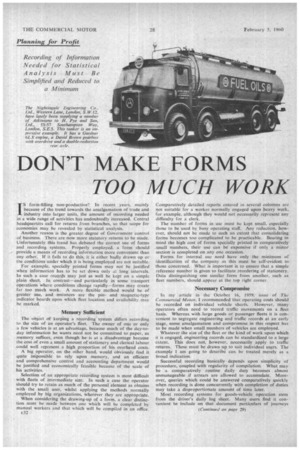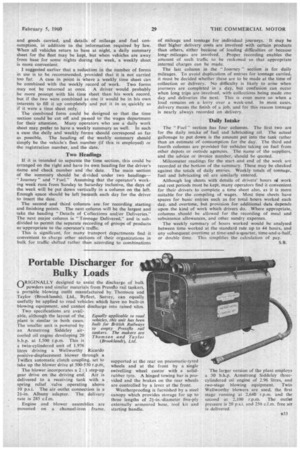DON'T MAKE FORMS TOO MUCH WORK
Page 78

Page 85

If you've noticed an error in this article please click here to report it so we can fix it.
Recording of Information Needed for Statistical Analysis Must Be Simplified and Reduced to a Minimum
IS form-filling non-productive? In recent years, mainly because of the trend towards the amalgamation of trade and industry into larger units, the amount of recording needed in a wide range of activities has undoubtedly increased. Central headquarters call for returns from branches, so that scope for economies may be revealed by statistical analysis.
Another reason is the greater degree of Government control of business. There are now more statutory returns to be made. Unfortunately this trend has debased the correct use of forms and recording systems. Properly employed, a form should -provide a means of recording information more convenient than any other. If it fails to do this, it is either badly drawn up or the conditions under which it is being employed arc not suitable.
For example. specially printed forms may not be justified when information has to be set down only at long intervals. In such a case records may just as well be kept on a simple plain sheet. In contrast—and particularly in some transport operations where conditions change rapidly—forms may create far too much work. A more flexible method would be of greater use, and instances are the pinand magnetic-type indicator hoards upon which fleet location and availability may he marked.
Memory Sufficient
The object of keeping a recording system differs according to the size of an operator's fleet. The owner of one or only a few vehicles is at an advantage, because much of the day-today information he wants need not be committed to paper, as memory suffices, even though heis at a disadvantage because the cost of even a small amount of stationery and clerical labour could well represent a high proportion of his overhead costs.
A big „operator. on the other hand, would obviously find it quite impossible to rely upon memory, and an efficient and comprehensive control and accounting department would be justified and economically feasible because of the scale of his activities.
Selection of an appropriate recording system is most difficult with fleets of intermediate size. In such a case the operator should try to retain as much of the personal element as obtains with the small user, whilst applying the methods normally employed by big organizations, wherever they are appropriate. When considering the drawing-up of a form, a clear distinction must be made between one which will be completed by manual workers and that which will be compiled in an office. Comparatively detailed reports entered in several columns are not suitable for a worker normally engaged upon heavy work, for example, although they would not necessarily represent any difficulty for a clerk.
The number of forms in use must be kept small, especially those to be used by busy operating staff. Any reduction, however, should not be made to such an extent that consolidating forms becomes too complicated to be practicable. Bearing in mind the high cost of forms specially printed in comparatively -small numbers, their use can be expensive if only a minor section is completed on any one occasion.
Forms for internal use need have only the minimum of identification of the company as this must be self-evident to those concerned. What is important is to ensure that a simple reference number is given to facilitate reordering of stationery. Data distinguishing one similar form from another, such as fleet numbers, should appear at the top right corner.
Necessary Compromise In my article in the October 16, 1959, issue of The Commercial Motor, I recommended that operating costs should he recorded on individual vehicle sheets. However, many operators often need to record traffic movements. on a fleet basis. Whereas with large goods or passenger fleets it is convenient to segregate engineering and traffic records at an early stage, some amalgamation and compromise in this respect has to be made when small numbers of vehicles are employed.
Whatever the size of the fleet or the kind of work upon which it is engaged. engineering records can be standardized to a large extent. This does not, however, necessarily apply to traffic returns. These must be drawn up to suit individual users. The example I am going to describe can be treated merely as a broad indication.
Successful recording basically depends upon simplicity of procedure, coupled with regularity of compilation. What may be a comparatively routine daily duty becomes almost unmanageable if arrears are allowed to accumulate. Moreover, queries which could be answered comparatively quickly when recording is done concurrently with completion of duties may take a disproportionate amount of time later.
Most recording systems for goods-vehicle operation stem from the driver's daily log sheet. Many users find it convenient to include on that document particulars of journeys (Continued on page 29)
and goods carried, and details of mileage and fuel consumption, in addition to the information required by law. When all vehicles return to base at night, a daily summary sheet for the fleet may be kept, but when vehicles are away from base for some nights during the week, a weekly sheet is more convenient.
I suggested earlier that a reduction in the number of forms in use is to be recommended, provided that it is not carried too far. A case in point is where a weekly time sheet can he combined with the weekly record of work. Two forms may not be returned at once. A driver would probably be more prompt with his time sheet than his work record, but if the two were combined as one it would be in his own interests to fill it up completely and put it in as quickly as if it were a time sheet only.
The combined form could be designed so that the time section could be cut off and passed to the wages department for their attention. Many operators who use a daily work sheet may prefer to have a weekly summary as well. In such a case the daily and weekly forms should •correspond so far as possible. The heading of the weekly summary should simply be the vehicle's fleet number (if this is employed) or the registration number, and the date.
Two Headings If it is intended to separate the time section, this could be arranged on the right and have its own heading for the driver's name and check number and the date. The main section of the summary should be divided under two headings— Journey" and "Fuel." Assuming that the operator's working week runs from Sunday to Saturday inclusive, the days of the week will be put down vertically in a column on the left. Enough space should be left beneath each day for the driver to insert the date.
The second and third columns are for recording starting and finishing points. The next column will be the largest and take the heading " Details of Collections andlor Deliveries." The next major column is "Tonnage Delivered," and is subdivided to permit the separate recording of groups of products as-appropriate to the operator's traffic.
This is significant, for many transport departments find it convenient to charge other sections of their organizations in bulk for traffic shifted rather than according to combinations of mileage and tonnage for individual journeys. It may be that higher delivery costs are involved with certain products than others, either because of loading difficulties or because longmileages are involved. Proper recording enables the amount of such traffic to be reckoned so that appropriate internal charges can be made. . .
The last column in the "Journey" section is for daily mileages. To avoid duplication of entries for tonnage carried, it must be decided whether these are to be made at the time of collection or delivery. No difficulty is likely to arise when journeys are completed in a day, but confusion can occur when long trips are involved, with collections being made one day and deliveries the next. This is even more so when a load remains on a lorry over a week-end. In most cases, dellvery means the finish of a job, and for this reason tonnage is nearly always recorded on delivery.
Daily Intake
The " Fuel " section has four columns. The first two are for the daily intake of fuel and lubricating oil. The actual gallonage to put down is the amount put into the tank rather than an estimate of consumption for the day. The third and fourth columns are provided for vehicles taking on fuel from other depots or outside agencies. The name of the suppliers, and the advice or invoice 'number, should be quoted.
Mileometer readings for the start and end of the week are recorded at the bottom of the summary. These may be checked against the totals of daily entries. Weekly totals of tonnage, fuel and lubricating oil are similarly entered.
Although log sheets with details of drivers' hours of work and rest periods must be kept, many operators find it convenient for their drivers to complete a time sheet also, as it is more suitable for the compiling of wages. Most time sheets have spaces for basic entries such as for totalhours worked each day, and overtime, but provision for additional data depends upon the kind of work which drivers do. Where appropriate, columns should be allowed for the recording of meal and subsistence allowances, and other sundry expenses.
The weekly summary of hours worked would be analysed between time worked at the standard rate up to 44 hours, and any subsequent overtime at time-and-a-quarter, time-and-a-half, or double time. This simplifies the calculation of pay.




























































































































